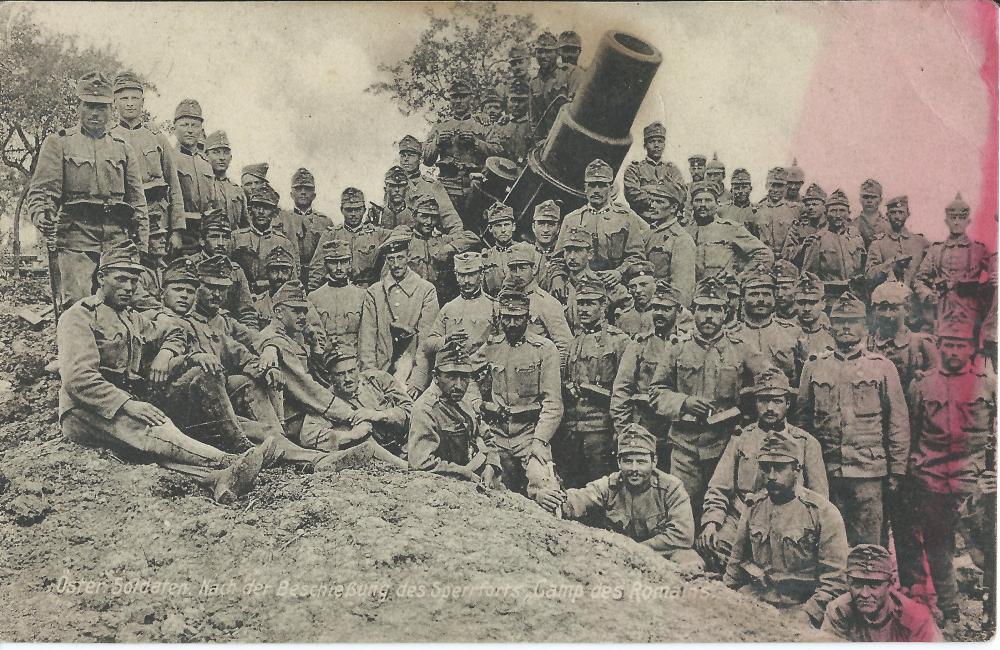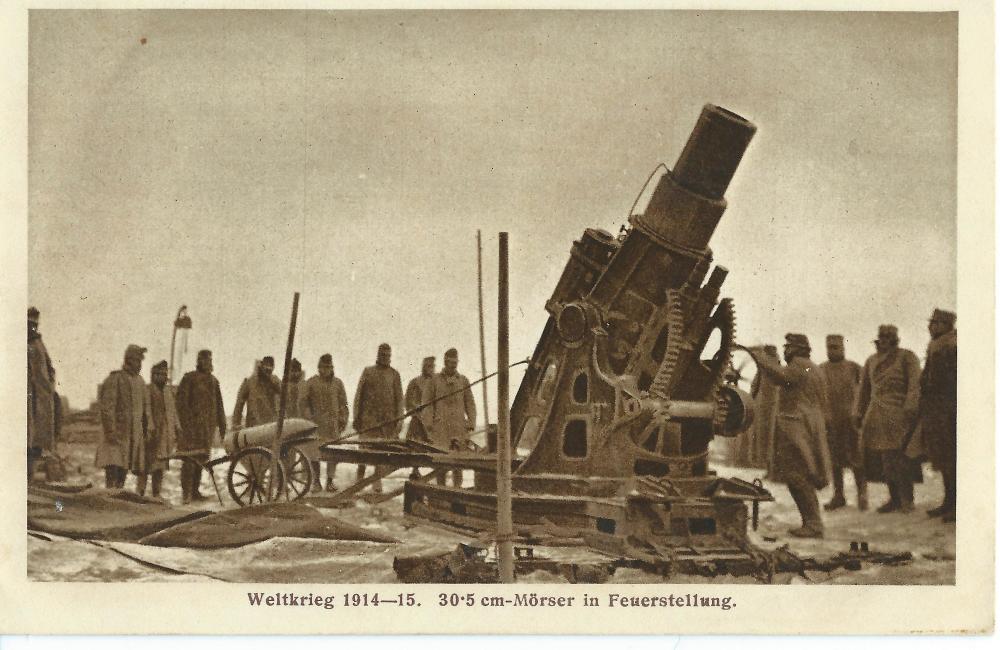-
Posts
5,629 -
Joined
-
Last visited
Content Type
Profiles
Forums
Blogs
Gallery
Events
Store
Posts posted by IrishGunner
-
-
-
Definitely, Polish. The abbreviation "Miedz. Ofic. Zaw." does not come to mind quickly, but "Konne" means "horse." The pennant is a traditional pennon color representing Cavalry during the 1920s-1939. My guess some kind of award for a cavalry horse competition.
0 -
It does look like a WWI Minenwerfer, but those upright cylinders on the base plate are not familiar. So, I can't guess it's type/model or country of origin. Certainly does not look like any German or Austrian mortar I've seen. It does look to be about 38cm. German WW2 Nebelwerfer were 28cm for high explosive rockets, but those were usually mounted in multiple tubes. So, I suppose it is possible this is a single rocket launcher. It would be useful to see all the info on the display card for more clues.
0 -
I actually just returned a medal to the man's family last month. I had the medal in my collection for over 13 years. It was a very valued piece in my collection - even written about extensively here on GMIC. And of course, as mentioned is possible, various members of the family while researching their ancestor, found the info on GMIC and contacted me through the forum. The first time was over 10 years ago. The first two family members shared info about the man and in closing always wrote, "If you ever choose to part with the medal..." Ten years ago, I felt as many here have stated; at some point, someone in the family, parted with the medal - for whatever reason - and I felt no obligation to return the medal. Especially after I found from the research of the man/medal, that it was a quite valuable collectible and worth considerably more than what I had paid. I even at one point was contacted by an author who was including the man in a book he was writing - and later published - and he wanted to obtain the medal. I declined. For the next ten years or so, I had no contact from anyone regarding the medal. Then in January, the man's great granddaughter contacted me via email. She related how her father and other family members had visited the man's grave at Sanders Keep for the 100th anniversary of his death in 1918 and how it had been an emotional experience for her father (the man's grandson). She wanted to know if I'd consider selling her the medal so she could give it to her father. My first thought was as it had been in the past; I did not want to sell the medal. But after pondering it a bit, I realized that it was just sitting in my drawer. Yes, I prized it - it had even continued to increase in monetary value over the past 10 years - but was I really "enjoying" it being in my collection? I truly enjoyed all the research I did on the man/medal/unit in the first years I owned the medal. But my collecting focus and research (and even interest in the hobby) has moved on and in different directions. The medal was just sitting in a drawer. So, I decided to sell - I didn't feel right quoting a price - I asked the woman to offer what she thought was fair and if I thought it was fair, I'd sell it to her. She made an almost spot on offer of what I thought was the fair market value of the medal. So, I sold it to her.
The bottom line, you have no obligation; there are several factors to consider and you have to do what is right for yourself as a collector. If you "value" the emotional satisfaction of gifting it to the family. Then do it. If you want to sell the item as a collectible with a negotiated price. Then do it. In the end for me, I decided that the medal was just sitting in a drawer; it no longer was a focus of research; it wasn't in my primary field of interest (that is it wasn't artillery). I was offered a fair price. I figure, I can turn that money into another "prized" piece - probably artillery related. Even if I sold it to another collector, there is no guarantee it would not "just sit in a drawer." So, if the family enjoys it for a short time and puts it in a drawer. That's their business. To me, it became a transaction like any other with just as if it were with another collector. And just maybe, the family will treasure the medal - and I have the satisfaction of knowing that I at least sold it to someone who might treasure the medal as much as I did when I owned it...
0 -
The idea that this is a "second row" in an interesting thought... There is no way to be sure of any theory. But I think we can now be reasonably sure this is a Belgian bar...
0 -
17 hours ago, Chris Boonzaier said:
Well.... Its about fricking time!
That was like dangling my junk at the beach and no senoritas swooning in awe .....
OH! I thought you dropped some raisins in your lap.
0 -
12 hours ago, Kvart said:
My money is on the Volunteer Combatants Medal (Belgium) too. Or the Belgian Congo Service Star.
But why no Victory medal?
I hadn't thought of why no Victory Medal. Good point...
12 hours ago, Stuka f said:The blue ribbon would be the Belgian Congo service star for me too..
Stuka, why do you think the Congo Service Star?
0 -
On 11/02/2019 at 04:49, SillyOldGrandad said:
It might be the Volunteer Combatants Medal (Belgium).
That is a guess I looked as well. That would make the bar appearing in correct order as in left to right of the photo. A Belgian who received the French and British medals. But the "combatant" part confused me a bit because I thought that the British War Medal was awarded only to Belgian civilians, not combatants. Unless of course, the Belgian Volunteer Combatatants Medal was also issued to civilians in some cases...
On 11/02/2019 at 03:35, Herman said:Maybe an Italian Valor Medal?
A possibility as that was awarded to ambulance drivers and red cross. Would mean that the person got around to both fronts. But I'm starting to lean in the Belgian direction as suggested by SOG.
0 -
Find of 2019? He probably lost it already....
 0
0 -
I am posting this one here because despite the order in the photo, I believe the British War Medal is in the senior spot of precedence. This is an odd combination to my eye. If we go left to right (again reverse the photo order): British War Medal, French War Commemorative Medal, Belgian War Commemorative Medal, and...a blue ribbon of an unknown medal. So, does this bar make sense? What could the blue ribbon represent?
My first thought was maybe a Red Cross volunteer or an ambulance driver. If British, however, wouldn't this have the British Red Cross Society medal (a white ribbon)? The American Red Cross has a blue ribbon medal, but were Americans awarded the British War Medal? I can see an American receiving the French and Belgian medals, but I don't see that happening with the British medal in my opinion.
Or is this just a fantasy piece?
1 -
Here is a photo with more clarity. And one from Fort du Camp des Romains, one of the French forts besieged at the start of the war by the Germans and supported by the Austrian siege mortars (it wasn't only the Belgian forts). This photo shows German (possibly Bavarian) troops mixed in with the Austrians.
0 -
It is the Škoda 30.5 cm Mörser M.11
There were 2 later variants, but this looks like the original 1911 model.
0 -
So, I was close then with the Sept '16 Verdun guess.
0 -
Since you highlighted the Feldpost stamp of the Jaegerregiment zu Pferde Nr, 12, I am guessing something to do with that unit. Sept 1916 they are at Verdun, right? Perhaps the fellow with the white ribbon in his buttonhole is someone famous?
0 -
I certainly wouldn't argue with your analysis. Well done. This could warrant a published article.
0 -
My wife and I are planning a week-long visit to Larissa, Greece area (actually staying near Olympus/Platamonas); we are planning on visiting some friends who live in Larissa. But we'll have time to explore northern Greece and am wondering about any recommended WWI sites. I am aware of CWGC cemeteries and memorials at Thessaloniki and Dorian. Any other memorials or sites of note worth visiting?
Also, we'll be driving from Athens to Larissa; any military related sites worth visiting along the way?
0 -
Alex, this is one of the honorary badges of Polish military units from the post-WWI period during the 1919-1921 Russo-Polish War in which Poland guaranteed its independence from Soviet Russia. Specifically, this badge is for members of the Pomeranian Front. In Polish: Odznaka Front Pomorski "Bóg Wolność i Ojczyzna"
English: Badge of the Pomeranian Front "God, Freedom, and Homeland"
You can Google and see several for sale. However, I always urge caution with anything Polish; Polish militaria is heavily faked. Unfortunately, I am not expert enough to offer any opinion on the originality of your posted badge.
0 -
I wonder what is the rounded item sticking out from the tunic of the center fellow with the EK ribbon.
0 -
Must be difficult to play an instrument on skis/snowshoes
0 -
I've never been to the Carpathians, but to me the Carpathian battle areas, even on the mountains, seemed to have more trees in the period WWI photos I've seen.
So, I'll offer another possibility. Julian Alps - Isonzo Front. I've climbed several times the mountains near Kobarid/Caparetto and Mt. Krn. Actually, went up Mt. Krn on 11 Nov 2004 in the snow. The valley we started in looked exactly like those in these photos as did the peaks. The Julians are just south of the Carnic Alps - now the border of Slovenia/Italy - and they are generally more rounded - although there are some jagged peaks. These photos also look very similar to WWI period photos I have seen (which are a lot) of the Isonzo Front.
0 -
Nice Pass. Did his war end in 1916 in the Vogesen?
0 -
Indeed a very nice group
0 -
Silver for officers? Bronze for NCOs/soldiers?
0 -
From my perspective, only the three with medals are veterans - medals, white rosetta, and age appearance. The rest, especially the ones in the front appear a bit young to be veterans; unless, of course, they were late war entrants and this is an photo taken shortly after the war. If that is the case, perhaps, they were ground crew and never were in a position to earn a medal.
Could this be a flying association or club, perhaps even a school, where an enthusiasm for flying and emphasis on aviation dominated? The veterans could be mentors or professors. And the remainder are members/students.
I don't see the Ehrenkreuz (but maybe that's a Bavarian thing); so, this photo might be pre-1934. However, the Nazis did come to power in 1933 and made significant changes to the education system, including an emphasis on military skills. So, I think my theory holds some beer.
0






Polish insignia ?
in Central & Eastern European States
Posted
Agreed; not Polish. But we've discussed this pattern of collar insignia on GMIC before; I am certain Central or Eastern European.